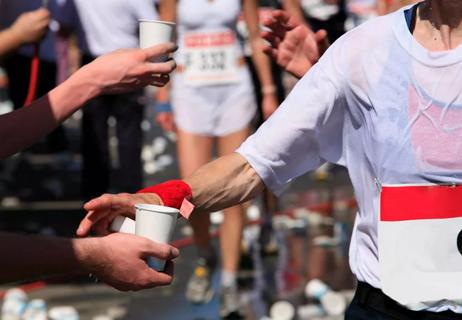Months of preparation go into readying your body to run 26.2 miles

A marathon stretches 26.2 miles (42.19 kilometers). It’s a long and physically taxing distance to run. Famously, the first marathon runner, Philippides, collapsed and died after his final steps.
Advertisement
Cleveland Clinic is a non-profit academic medical center. Advertising on our site helps support our mission. We do not endorse non-Cleveland Clinic products or services. Policy
Yet despite the grueling nature of a marathon, the race itself is the shortest part of the journey. Months of training and preparation go into building strength and endurance to take on the challenge.
It’s a process that requires planning to avoid injury and cross the finish line healthy. So, how do you get there? Let’s find out from physical therapist, Monica Betchker, PT.
Most marathon training plans range from 12 to 20 weeks to give your body adequate time to prep for the distance. The amount of time you need varies depending on your fitness level and goals.
“Training plans are typically broken out into beginner, intermediate and advanced options,” says Betchker. “Figure out where you are in those categories first.”
Ideally, select a race you’d like to run and work backward to set a timetable. Training plans typically start at your current comfort level and build in a slow and steady manner to minimize injury risk.
Before you get into serious training, think about taking these critical first steps.
You’re going to be spending a lot of time on your feet over the next few months, so make sure you’re protecting your tootsies.
Proper-fitting running shoes are critical for marathon training. Shoes that are too small or too large can cause blisters on your feet or rub your ankles raw, which will not make you feel like getting in miles.
Advertisement
But the importance of a good fit goes beyond comfort and skin issues: “You predispose yourself to injury if your shoes aren’t right — everything from muscle strains to shin splints to stress fractures,” says Betchker.
She recommends getting a comprehensive fitting for running shoes at the start of your marathon training. (That goes for long-time runners, too.) Fittings are regularly offered at running specialty stores or even through a physical therapist.
Moisture-wicking material is your best friend when it comes to socks, shirts and shorts for marathon training, says Betchker. Look for fabrics made of polyester, nylon or bamboo, which draw sweat away from your skin to keep you dry and minimize chafing.
Invest in a few runner-friendly garments that will allow you to run comfortably whether it’s hot or cold outside, too. You may need to train in both.
A gait analysis is an evaluation of your running form to assess your biomechanical movement. Everything from where you land on your feet and your knee placement to your posture is examined.
The evaluation can pinpoint bad form in advance of logging your miles, allowing for changes that increase running efficiency and decrease your chance of injury, notes Betchker.
A gait analysis can be beneficial to both novice and veteran runners.
Begin your marathon training where you’re comfortable. For a beginner, that might mean running 15 miles in week one of training. Those with some experience may start at upwards of 40 miles per week.
From there, though, common rules apply across most training plans. The general rule of thumb is to increase weekly mileage by no more than 10% in any given week during training.
The reason? Doing too much too soon can increase your risk of injury.
But Betchker says the 10% rule can be modified depending on how well-conditioned you are and what your current base mileage is. “We find that for many people, the 10% rule might not be challenging enough,” she notes.
But remember, the goal is the marathon finish line. Overdoing it early can create issues later. Trust your plan and build your mileage sensibly until it’s time to taper. (More on that later.)
A five-to-10-minute dynamic warm-up and cool-down is usually the sweet spot for most people.
When warming up, the focus is on getting your body moving and muscles activated for the training session, says Betchker. Dynamic stretching (movement that mimics running) is great for warm-ups.
Advertisement
Cooling down is all about lowering your heart rate and relaxing. Make sure to stretch those muscles, too, which can keep them from tightening up and causing stiffness.
Pro tip: Try foam rolling to relieve sore or achy muscles and help your body’s repair process.
Overuse injuries are common in marathon training, a byproduct of doing the same motion repeatedly while grinding out miles.
Embracing cross-training activities such as cycling and swimming can target different muscle groups while advancing your fitness. This allows you to build strength and endurance while also limiting wear and tear.
An elliptical workout is especially beneficial for those who might already be injured because it mirrors the movement of running without the impact.
Betchker says your effort level during cross-training should match what you give during running.
“Try to keep the ratios similar if you’re subbing in cross-training for a run,” she adds. “If it takes you an hour to run five miles and that’s in your plan, then you can swap it for an hour of cross-training instead.”
Can you lift weights during marathon training? Absolutely! But your lifting needs to complement — not compete with — your running schedule.
Advertisement
And dial down the intensity of your strength workouts as your running mileage increases and peaks during marathon training. Your body is already being taxed during this period. Don’t add to that stress it by trying to lift more.
As your marathon gets closer on the calendar, strength training should consist primarily of calisthenics, ball exercises, Pilates or other workout methods with minimal external resistance.
(Basically, it’s more about muscle maintenance than muscle building as race day approaches.)
To state the obvious, you’ve already made a healthy choice by starting your marathon training. Physical fitness is a key part of a healthy lifestyle.
But it’s not the only part. During your training, it’s also important to:
Advertisement
The best thing to do just before your marathon is … well, to do less. Your mileage two weeks before the race should be reduced by 25% to 50% versus the previous week. You should further cut this mileage in half the week before the race.
The idea is to let your body fully recover from any training-induced muscle damage, explains Betchker. Basically, a little rest is best at this point.
So, resist the temptation to squeeze in one more long run or a tough workout. Your goal now is to have fresh legs for the race. And don’t worry — you won’t “de-condition” during this tapering period.
“Your training has you as ready as you can be,” emphasizes Betchker.
Training for a marathon can be a marathon itself, notes Betchker. You’ll likely log more than a million steps running before setting one foot across the starting line.
Race day is a celebration of that preparation and dedication. Enjoy the moments across those 26.2 miles. Focus on the experience and soak in the atmosphere. Smile a lot, even when your leg muscles start to object a bit.
And when you cross that finish line, you’ll have earned the right to be called a marathoner.
Learn more about our editorial process.
Advertisement

Before, during + after nutrition tips

Simple swaps improve a comfort food staple.

Simple swaps improve a comfort food staple.

CHANGE ADDED NOW Lorem ipsum dolor sit amet. Non voluptatem quibusdam qui nobis laborum in animi autem est veritatis temporibus quo impedit eius. Quo possimus quaerat sit odio omnis est commodi consequatur vel assumenda itaque. I ADDED THIS JUST NOW CHANGE

A sweet twist on this holiday dish, complete with fiber and antioxidants

There’s a fine line between emotional and physical hunger

Type 2 diabetes isn’t inevitable with these dietary changes

Applying a hot or cold compress can help with pain